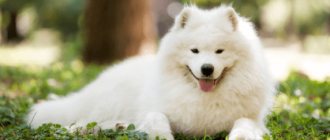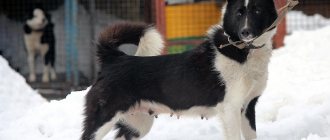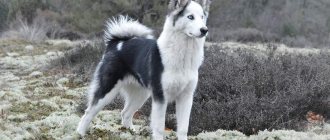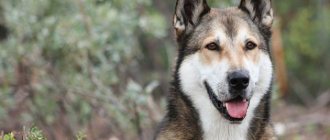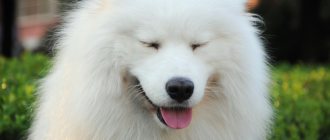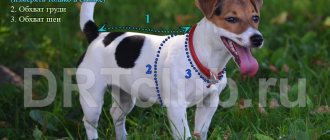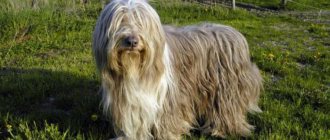Video
* We invite you to watch a video about the Karelo-Finnish Laika . In fact, in front of you is a playlist in which you can select and watch any of 20 videos about a given dog breed by simply clicking on the button in the upper right corner of the window. In addition, the material contains quite a lot of photos. By looking at them you can find out what the Karelo-Finnish Laika looks like.
Rate the material!
[Total votes: 2 Average: 3]
The Karelo-Finnish Laika is an ancient breed of dog that has evolved over centuries. These active animals combine all the qualities necessary for people: they are hunters, watchmen and companions. The dogs were raised not only by people with whom they had spent many centuries side by side, but also by the harsh climate.
Purpose
Karelo-Finnish huskies were bred by Soviet dog handlers to hunt upland game: squirrel, hare, wild boar, bird, marten. These animals can be used to bait bears.
A sharp mind, loyalty and excellent appearance over time made it possible to use these dogs as companions. Now they can be kept in apartments and cottages.
History of the origin of Karelian-Finnish huskies
The Karelian-Finnish Laika (aka Finnish Spitz) is a breed of dog from Central Russia, where it lived for several hundred years. The dogs lived in the northern regions among the Finno-Ugric tribes, who developed this breed. Therefore, the Karelian-Finnish Laika fully satisfies the needs of a person living in a communal-tribal system: she is an excellent hunter, a good guard and an excellent companion.
Since Karelian-Finnish huskies lived isolated from the rest of the world, they were not able to interbreed with other dog breeds. This made the breed a kind of aboriginal, since they developed strictly in the same way, crossing only within the breed and focusing only on hunting. Therefore, dogs have remained unchanged for hundreds of years without the opportunity to diversify their genetic potential.
Interesting fact: The arrival of the railroad in 1880 was a decisive moment in the spread of the breed. Tribes were no longer isolated, and dogs, following their people, began to actively crossbreed with dogs of other breeds. Purebred Karelian-Finnish huskies have almost disappeared.
Hugo Roos, a famous Finnish athlete and amateur hunter, became the first person to see breed qualities in the Karelian-Finnish Laika. It was he and his friend Hugo Sunberg who started breeding dogs, looking for purebreds for breeding. They also established the first breed standard, which was announced in the Finnish magazine “Sporten”. Hunters learned about the Karelian-Finnish Laika breed, which is why it quickly gained popularity.
At the same time, the first Finnish Kennel Club was created. The dog breed spreads throughout Europe, but due to World War II, the numbers suffered greatly. By 1979, the Karelian-Finnish Laika was recognized as the national pride of Finland.
Karelo-Finnish Laika - description of the breed
The Karelo-Finnish Laika has a bright, memorable exterior. The head has the shape of a triangle with a wide rounded nape and a wedge-shaped muzzle. The forehead is longer than the muzzle, which is shaped by a slightly rounded nose. The brow ridges are well defined, which makes the dog’s gaze expressive.
The lips of the Karelian-Finnish Laika are thin, tightly compressed, and the teeth are completely hidden. The nose is small, black, with a dense nose. The eyes are oval in shape, and the inner corners are slightly slanted towards the bridge of the nose. The eyelids fit tightly to the eyes, which makes the dog resistant to many eye diseases. Eye color can vary from dark brown to beige.
The ears of the Finnish Spitz are erect with dense cartilage. They have the shape of pointed triangles, but are not large and not excessively long, but are proportional to the head. The edges of the ears are sharp, the structure of the ears themselves is elastic and flexible, but not soft.
The torso is square in shape, the paws are slightly longer than necessary in proportion. The dog has a strong and long neck, a straight, well-developed back and high withers. The transition to the croup is smooth, without sharp lines. The legs are strong, set strictly parallel to each other, which makes the dog stable. The joints are tight, the muscles are dry. The rear paws are set slightly wider than the front paws, allowing the dog to push off the ground for wide jumps.
The tail is wrapped towards the back in a roll and is in close contact with the croup. Especially in puppyhood, these dogs resemble foxes. The height of an adult male can reach 50 cm, and an adult female grows up to 47 cm.
Popular colors of Karelian-Finnish huskies
Karelian-Finnish huskies are very similar to foxes, especially in puppyhood. In addition to the sharp muzzle, their honey-red coat color makes them similar to these animals.
But even this seemingly simple color has a number of features that must be observed according to the standard:
- The inside of the paws, belly area, and chin should be lighter than the main color of the dog’s body;
- The tail at the very tips and middle of the back should have small dark marks, similar to light tan marks;
- There are small white marks on the chin, abdominal area and chest. They are not mandatory, but are allowed by the breed standard.
If the dog does not meet these requirements, then the individual is subject to culling from the breed - it is not crossed with other dogs in the kennel, but is sold at a reduced price as a pet-class pet. Because of these nuances, you should become thoroughly familiar with the puppy you are about to purchase.
The fur of Karelian-Finnish huskies is also special in its own way. The guard hair is very hard, and the hardest hair is located along the back, on the neck and on the shoulder blades. On the muzzle and at the bottom of the paws the hair is shortest and smoothest. The entire coat lies in a dense layer on the skin, and on the body the guard hair reaches a length of 5 cm. The hair is longer only on the tail and the peculiar “pants” - fluffy hair on the dog’s hind legs - up to 7 cm.
The undercoat of the Karelian-Finnish Laika is soft, thick and dense. Combed wool can be used to knit warm clothes, especially mittens and scarves. The fur on the neck forms a fluffy thick collar, shimmering with gold.
Description and breed standard
Coat color is the calling card of the Finnish Spitz. The more “fire” in a color, the better.
| Gender of the dog | Height at withers | Weight |
| Males | 43-50 cm | 12-13 kg |
| Bitches | 38-46 cm | 7-10 kg |
Red husky puppies are born... not red. They are brown, black, dark gray; Only with age does the fur acquire a fiery color.
Puppies
According to the standard, the Karelian-Finnish Laika should be:
- The ears are erect, triangular, with pointed tips.
- Coat: undercoat thick, short, soft; The guard hair is hard, straight, up to 5 cm long.
- The eyes are hazel or dark brown.
- The tail is usually curved and curls over the back in a ring.
- Well developed neck muscles.
- The head is small, slightly pointed towards the nose.
- Color red, all shades; White markings on the chest, legs, and tip of the tail are acceptable.
- bite .
Character and habits of Karelian-Finnish huskies
Karelo-Finnish huskies are active, energetic, cheerful dogs. They are good companions who show loyalty to their owner and the entire family. With their families, these animals are very kind and affectionate, but they show maximum caution, even distrust, towards strangers. Karelian-Finnish huskies are not aggressive, so they get along well with children and play with them with interest.
We must not forget that Karelian-Finnish huskies are, first of all, born hunters, and the hunting qualities in these dogs have been formed over centuries. Therefore, the Finnish Spitz will perceive all small animals exclusively as prey.
Important fact: You should not have birds and hamsters in a house where a Karelian-Finnish husky is kept. Also, while walking, you should keep your dog on a leash so that it does not run after a bird or squirrel. Finnish Spitzes are neutral towards cats and small dogs.
Karelian-Finnish huskies need strict training and good upbringing, which is important to start from early childhood. Socialization is an important part of this dog's maturation. If the animal does not communicate enough with other pets, the dog may grow up to be aggressive, uncontrollable, or overly fearful. Every day it is worth training the Karelian-Finnish Laika, reinforcing the rules of behavior.
Karelo-Finnish Laikas need a firm hand. A permissive attitude towards training can lead to the dog seeing itself as the leader and the family as its pack. Then she may even show aggression towards people, which is unacceptable for any dog.
Owner reviews
Today there are quite a few owners of such dogs in our country. Nevertheless, most of them claim that they are very happy to be the owners of these particular animals. Hunters especially leave a lot of positive feedback. They think it's a great dog. The Karelian-Finnish husky is easy to train, has an excellent hunting instinct, is obedient and not picky.
A separate group of reviews belongs to owners who keep such a dog as a companion. Here opinions are a little divided. Most believe that the animal is excellent for this purpose - it is smart, loyal, neat, practically does not shed, and has no specific smell. However, there are also complaints about the stubborn and wayward nature of their pets. The dog is very wary of strangers, although it does not show aggression.
Interesting facts about Karelian-Finnish huskies
Karelo-Finnish dogs are truly brave animals. They are devoid of a sense of fear and can protect their owner from any danger, fearlessly rushing at an opponent and stunning him with a ringing bark. This feature was developed in the dog thanks to the centuries-long development of hunting qualities: even wild boars and bears were hunted with these small huskies. Karelian-Finnish huskies in a flock are able to surround a large animal and keep it in a circle for a long time, barking and lunging until the owner kills the game.
Karelo-Finnish huskies have phenomenal health. These are strong, muscular dogs that do not catch colds and generally tolerate the cold well. Hot weather, on the contrary, negatively affects the well-being of dogs. That is why breeders recommend keeping Karelian-Finnish huskies in outdoor enclosures, letting them home only in cold or hot weather, so that the dogs do not overheat.
The name of the Karelian-Finnish Laika speaks for itself: the dog is tied to two geographical territories at once. The breed was formed for a long time on the territory of Karelia, but it was documented in Finland.
Karelo-Finnish huskies are one of the loudest and noisiest dog breeds existing in the world. This is her most important purpose as a hunter: her loud barking disorients the animals and makes them panic. For this, the dog is valued by hunters.
Championships among dogs of this breed in Finland have their own separate category: King of the Barkers. At the end of the inspection of the dogs, they are allowed to bark to their heart's content to determine the loudest dog. It was at this championship that it was found that the Finnish Spitz can bark up to 160 times per minute.
Color
Light color is an undesirable feature of the breed. What does this definition mean? In the Russian version of the standard, light wool is referred to as an undesirable fawn color. Nevertheless, the phrase “red of all shades...” probably also implies him. But there is another standard that the Karelian-Finnish Laika must meet. The dog breeds (description) in it are slightly different from the Russian version. And this mainly concerns color. The International Standard for the Finnish Spitz, the breed's second name, clearly states that the coat should be red or golden brown, preferably a bright color. It must be said that the bright red color is the calling card of the breed.
Pros and cons of Karelian-Finnish Laikas
Like all dog breeds, the Karelian-Finnish Laika has its own advantages and disadvantages that must be taken into account when buying a puppy.
Let's first look at the advantages of this breed:
- Karelo-Finnish huskies have a stable psyche. They are not so easy to piss off. Adult dogs do not give in to fear and do not fall into sudden aggression - the character of an adult Karelian-Finnish husky is unchanged and clearly visible to the owner;
- Karelian-Finnish huskies do not require much care and serious financial costs for maintenance. This is one of the most unpretentious dog breeds in the world. For example, they can be kept in an outdoor enclosure, and this option is even more preferable for this breed;
- Finnish Spitz live long. The average life expectancy is 15 years, but with good care and moderate physical activity they can live up to twenty years;
- Dogs of this breed have many purposes. For example, they can be excellent watchmen, since their loud bark alerts them when strangers approach the protected area. Hunters still use Karelian-Finnish huskies. Also, Karelian-Finnish huskies become companions for people who prefer an active lifestyle.
Now let's look at the disadvantages of this breed:
- This is a stubborn breed of dog. If the dog does not feel the firm hand of the owner, then he will refuse to carry out even familiar commands. These dogs love to get the better of people, so Karelian-Finnish huskies require strict training;
- Finnish Spitz dogs run a lot and generally expend a huge amount of energy, so they love to eat. It is important to properly balance the diet of these active dogs so as not to accidentally harm their body;
- These dogs are very active, so they are not suitable for families who prefer to spend time at home. They need physical activity, long runs and generally walks in nature.
Character
The dog has a temperament that falls somewhere between that of a typical Spitz and a typical herding breed. The Finnish Lapphund has a very close bond with his family, to whom he is devoted. Unlike many Spitz dogs, he is not usually a one-person dog. This is a dog that forms equally strong bonds with all family members.
Finnish Huskies have a legendary reputation among families with children, and with proper training and socialization, this breed always gets along very well with them. Not only are they very affectionate with children, but they are also very playful. Many of the breed actively seek out the company of children to play with, and many of these dogs have become a child's best friend.
With proper training and socialization, most dogs are very friendly and will interact with strangers. In fact, excessive and inappropriate greeting is probably a more common behavioral problem in these dogs than aggression towards humans. F
Indian Lapp Huskies are extremely alert and very vocal, making them excellent and reliable guard dogs. However, this breed would be a poor choice as a guard dog, as most members would warmly greet an intruder rather than be aggressive towards them.
Although dogs are usually very good-natured with people, they often develop problems with aggression towards other animals. The Finnish Lapphund is not an exclusively aggressive breed, and most of these dogs will get along well with other dogs if properly trained and socialized.
However, this breed is known to have problems with aggression towards other dogs. Males in particular are quite aggressive towards other male dogs, and many fanciers advise keeping males only with females. When raised with other species such as cats and horses, most of the breed will get along well with these animals. Owners should always remember that these dogs have a very strong herding instinct and will likely try to herd other animals whether they want to or not.
In addition, some huskies exhibit quite strong predatory instincts and may try to attack and kill animals of another species.
This is an extremely intelligent breed and is considered the easiest of all Spitz breeds to train. The dog usually learns quickly and is quite obedient. Finnish Huskies have been very successful at the highest levels in almost every dog sport they compete in, including agility and obedience competitions. With the exception of those tasks that require extreme strength or aggressiveness, there is probably nothing that the Finnish Lapp Husky cannot do. However, they are not the easiest breed to train. Some representatives can be stubborn and some can be very stubborn. Although this dog is very capable and willing to work, inexperienced trainers may find it easier to work with a breed such as a Labrador Retriever or Poodle.
Bred to follow herds of reindeer for hundreds of kilometers across some of the most challenging terrain on Earth, the Finnish Lapphund is a highly energetic breed. These dogs require a minimum of 1 hour of vigorous physical activity each day, but a few hours more would be preferable.
This dog is a great jogging or cycling companion. Dogs that are not given adequate energy outlets will almost certainly develop behavioral problems such as destructiveness, hyperactivity, excessive barking, overexcitability and nervousness. Although the Finnish Lapphund is now primarily kept as a companion dog, it is still a working dog at heart. These dogs are happiest when given a job and need some form of mental stimulation to stay happy and sane.
Many owners find agility, competitive obedience, and herding training to be very beneficial for these dogs. A high level of activity is actually highly desirable for many active families who enjoy cold weather.
The Finnish Lapphund is physically capable of going on any adventure, no matter how extreme, and this breed loves long hikes in the mountains, cross-country skiing, or running for hours next to snowmobiles.
Potential owners should be aware of the dog's tendency to bark. Although the Finnish Lapphund is typically significantly less vocal than many other Spitz dogs, this dog still barks much more than most breeds.
With proper training and exercise, barking can be controlled, but it cannot be eliminated completely. Combined with the breed's very high exercise requirements, the barking means that this breed does not adapt well to apartment life and the dogs need yards, preferably with large areas.
Breeding Karelian-Finnish huskies
A female dog's first heat begins at approximately 14 months of age. This estrus lasts up to 22 days and occurs twice a year. A dog should be bred only after it has gone through three heats. Then the animal’s body is completely ready to bear offspring. During estrus, strict precautions should be taken. The dog will actively search for a male, so all walks must be strictly on a leash.
Even the most obedient dog will try to run away. You cannot leave a bitch in heat alone in an open enclosure, as she will find a way out into the open. In the cold season, the Karelian-Finnish husky, even being resistant to frost, can chill its reproductive system, so it is better to keep it warm. If you intend to get offspring from your dog, then after the third heat, start looking for a suitable kennel where there are purebred males.
As a rule, mating takes place without any particular difficulties. Dogs are willing to make contact, since the pack instinct is clearly developed in them - Karelian-Finnish huskies have always been kept in small groups, and these same groups went hunting with people.
Pregnancy lasts approximately 56-77 days. Early or late birth can lead to the death of the puppies or even the mother herself, so the day of mating should be marked on the calendar and monitor the progress of the pregnancy. In general, Karelian-Finnish huskies are in excellent health, so, as a rule, there are no complications during pregnancy.
The first pregnancy usually brings many puppies: five to six puppies. They should all have a tan-colored coat and set white markings. The more pregnancies a dog experiences, the fewer puppies it will give birth to each time, and the less likely it is to have healthy offspring.
Caring for Karelian-Finnish huskies
Karelo-Finnish huskies are medium-sized dogs, which is why many people decide to keep this breed of dog at home. In fact, keeping these dogs in an apartment is a big mistake. These dogs are very active and mobile, so they require keeping in a spacious enclosure. In addition, the apartment may be too hot for them. The thick undercoat and warm fur allow the dog to feel great even in the cold winter.
It is worth putting an insulated booth in the enclosure, and the space itself should be well protected from the wind so that the dog does not become hypothermic. Usually Karelian-Finnish huskies bask collectively, pressing their bodies against each other. If the dog is alone, then you should take care of how it will keep warm.
Interesting fact: Dogs of this breed need regular exercise. If the animal does not have the opportunity to realize the huge amount of energy that is naturally inherent in these dogs, then it may become depressed. Therefore, long walks and jogs are an important part of caring for your dog.
However, a Karelian-Finnish husky puppy should only be kept at home. A fragile body is susceptible to colds and other diseases. Caring for thick fur is not difficult. Once a week, the dog needs to be brushed with a special brush for fluff, and when shedding, it is better to brush it daily. You need to bathe your dog when it gets dirty, but not more than once every four months.
The dog's eyes, teeth, ears and claws require special care. They should be examined every day so as not to miss a possible disease or inflammatory process. In addition, although the dog has good immunity, it needs to be vaccinated and regularly examined by a veterinarian.
Pet care
The size of the Karelian-Finnish Laika allows it to be kept not only in a private house, but also in an apartment. Like any living creature, you will need to:
- brushing your teeth This procedure is performed from a very early age, using only special toothpaste. Also, to prevent dental disease, chew bones or special toys;
- ear cleaning. Carry out as they become dirty;
- trimming nails. This should only be done if they have not worn off on their own.
In general, the breed is easy to care for. The main points that you need to pay special attention to are walking and combing.
The size of the Karelian-Finnish Laika allows it to be kept not only in a private house, but also in an apartment.
Walk
These dogs are active, so they prefer long walks and just being in the fresh air. When starting to care for a Karelian-Finnish Husky puppy, you should keep him in an apartment or house until the first molt, which is considered the stage of growing up. After this, you can accustom him to longer walks and move him to an enclosure or kennel. The dog’s home should serve as a reliable shelter from wind and cold. At the same time, the breed has very warm fur, so don’t be afraid to take the animal out into the yard in winter.
Combing
Wool deserves special care; it is a kind of indicator of health. It is enough to bathe 2-4 times a year; the fur does not have a specific smell. Brushing is required once a week. The purpose of this procedure is to get rid of old, dead hairs to prevent matting. During the molting period, this must be done very carefully, every day. A balanced diet has a huge impact on your pet's appearance.
Wool deserves special care; it is a kind of indicator of health.
Veterinary
The Finnish Spitz has good health and excellent immunity. The average lifespan is about 11 years, but with proper care and attention, your four-legged friend can live up to 16 years. It all depends on timely vaccinations, timely detection of diseases, as well as a complete diet rich in vitamins and minerals.
Vaccinations
Vaccination is of great importance for a puppy, especially before taking the baby for a walk for the first time or introducing him to his relatives. It is important to adhere to a specific vaccination schedule:
Vaccination is of great importance for a puppy, especially before taking the baby for a walk for the first time.
- Deworming. This procedure is performed for the first time at the age of one and a half months.
- Vaccination against enteritis and plague. Do it at the age of 2 months. After 2 weeks, devaccination is carried out.
- Rabies vaccination. It is carried out after changing teeth. This vaccination is especially necessary for those who are going to take their dog hunting.
Any vaccination does not give you a 100% guarantee; it is just a preventive measure. You must take care that the puppy is not overtired, does not get hypothermic, and also avoid exposure to drafts.
Mating
Mating takes place on the 3rd heat, about 3 years of age, this period is considered the most suitable. At the time of mating, the female must have all her vaccinations and must also be dewormed. Pregnancy lasts approximately 2 months. It is almost impossible to identify it, since it is not visible from the figure, unless the appetite increases slightly. The Karelian-Finnish husky can have from 2 to 4 puppies. Photos of Karelian-Finnish Laika puppies can be seen on the Internet.
Any vaccination does not give you a 100% guarantee, it is just a preventive measure
Diet of Karelian-Finnish huskies
Finnish Spitz are incredibly voracious, largely due to the fact that they spend a lot of energy every day. They run a lot and love physical activity, so the diet should take into account the active lifestyle of this dog.
When the puppy is one and a half months old, he begins to feed himself. A growing dog should be fed approximately five to six times a day. At three years, the regularity of feeding decreases to four times a day, and at five years - to three. An adult dog eats twice a day, and this is enough to keep the dog well-fed and active.
Important fact: Food should be balanced and fresh. It is highly not recommended to feed the dog from the owner's table: firstly, it erases the boundary between the pet and the owners, which is unacceptable in the case of this breed; secondly, this food may simply be harmful to the dog.
Most of the diet of the Karelian-Finnish Laika should be meat. Choose low-fat foods: chicken, turkey, veal. Dogs readily eat offal, such as liver, kidneys, hearts, lungs, and so on. You should avoid fatty pork and, especially, sausage.
Vegetables must be added to the meat: cabbage, carrots, cucumbers, tomatoes and herbs. This will provide your dog with the required amount of fiber. Some dog owners grind the meat into a single mass in a blender, but breeders do not recommend this. A dog must chew and bite to maintain its teeth. This is why it is also worth giving dogs large, non-tubular bones or special artificial treats that can be chewed.
It is strictly forbidden to feed the Karelian-Finnish Laika the following foods: herbs, pasta, chocolate and all sweets, fried foods, spicy foods, tubular bones (they can get stuck in the throat). Fresh river fish is also excluded from the diet, as it may contain parasites.
Nutrition
The Finnish Husky requires special food, so pay special attention to this issue. It is not recommended to feed pork or chicken meat, as it is very fatty for your pet. Also, you should not feed him bones to avoid stomach problems.
It is important that your diet always includes lean meat. Beef is good. Food is usually divided into small pieces to make it easier for your pet to eat. It is also recommended to include the following foods for complete nutrition:
- vegetables;
- dairy products;
- porridge;
- broths.
Provide your pet with access to drinking water. Also establish a feeding schedule so that the dog is accustomed to eating at the same time. An adult dog can be fed no more than 2-3 times a day.
Diseases and health problems
As already mentioned, Karelian-Finnish huskies are characterized by good health and good immunity. Because of this, the list of diseases to which these dogs are susceptible is very small. One of the most common diseases that Finnish Spitz owners face is obesity.
Obesity occurs if the dog lives in an apartment and the owners pay insufficient attention to its physical activity. An active pastime ensures that the dog does not become overweight. Also, the Karelian-Finnish husky can become significantly fat if it does not eat properly and eats a lot of food from the master’s table.
Epilepsy in Karelian-Finnish huskies is rare and is a congenital disease. Typically, puppies with epilepsy rarely survive into adulthood, but if it occurs in a mature dog, you should immediately contact a veterinarian. Such dogs are prescribed treatment and organized a special regime that will not provoke seizures in the animals.
Interesting fact: Sometimes Karelian-Finnish huskies, like other dogs, have allergies. It usually manifests itself when eating specific foods. Then it is worth tracking down what exactly in the dog’s diet causes an allergic reaction and completely eliminating this product from its diet.
Since Karelian-Finnish dogs are very active, it is worth regularly vaccinating them and giving them drugs that get rid of parasites. During a walk, they may eat something from garbage or waste, so infestation with parasites is very likely. You should also treat your huskies for ticks if you walk in parks and forests.
Character of the Karelian Laika
This dog is a very smart, attentive and sensitive creature that has the makings of a leader. However, the dog owner must be shown who is boss in the house. Only in this case will the Finnish Spitz completely respect and obey him.
Owners of dogs of this breed note that their pets are cheerful and cheerful. They are loyal and devoted to their owner, and they are wary of strangers, but without malice and quite tolerant.
Since the Karelo Finnish Husky has a playful disposition, it gets along well with small children. However, you need to remember that the dog will not tolerate disrespectful treatment.
